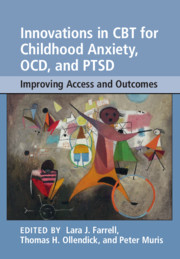Book contents
- Innovations in CBT for Childhood Anxiety, OCD, and PTSD
- Innovations in CBT for Childhood Anxiety, OCD, and PTSD
- Copyright page
- Contents
- Figures
- Tables
- Contributors
- Preface
- Acknowledgments
- Part I Anxiety Disorders
- Part II Obsessive-Compulsive Disorder
- Part III Post-Traumatic Stress Disorder
- 25 Trauma-Focused Cognitive Behavioral Therapy
- 26 Advances in the Assessment of PTSD in Children and Young People
- 27 New Technologies to Deliver CBT (Including Web-Based CBT, Mobile Apps, and Virtual Reality)
- 28 Eye Movement Desensitization and Reprocessing (EMDR)
- 29 Innovation in Early Trauma Treatment
- 30 Pediatric Post-Traumatic Stress Disorder
- 31 Enhanced Family-Based Interventions for Children Who Have Been Traumatized by Physical Abuse and Neglect
- 32 Treatment of PTSD and Comorbid Disorders
- 33 Transdiagnostic Treatment for Youth with Traumatic Stress
- 34 Dissemination and Implementation of Evidence-Based Treatments for Childhood PTSD
- 35 New Wave Therapies for Post-Traumatic Stress Disorder in Youth
- Index
- References
33 - Transdiagnostic Treatment for Youth with Traumatic Stress
from Part III - Post-Traumatic Stress Disorder
Published online by Cambridge University Press: 12 April 2019
- Innovations in CBT for Childhood Anxiety, OCD, and PTSD
- Innovations in CBT for Childhood Anxiety, OCD, and PTSD
- Copyright page
- Contents
- Figures
- Tables
- Contributors
- Preface
- Acknowledgments
- Part I Anxiety Disorders
- Part II Obsessive-Compulsive Disorder
- Part III Post-Traumatic Stress Disorder
- 25 Trauma-Focused Cognitive Behavioral Therapy
- 26 Advances in the Assessment of PTSD in Children and Young People
- 27 New Technologies to Deliver CBT (Including Web-Based CBT, Mobile Apps, and Virtual Reality)
- 28 Eye Movement Desensitization and Reprocessing (EMDR)
- 29 Innovation in Early Trauma Treatment
- 30 Pediatric Post-Traumatic Stress Disorder
- 31 Enhanced Family-Based Interventions for Children Who Have Been Traumatized by Physical Abuse and Neglect
- 32 Treatment of PTSD and Comorbid Disorders
- 33 Transdiagnostic Treatment for Youth with Traumatic Stress
- 34 Dissemination and Implementation of Evidence-Based Treatments for Childhood PTSD
- 35 New Wave Therapies for Post-Traumatic Stress Disorder in Youth
- Index
- References
- Type
- Chapter
- Information
- Innovations in CBT for Childhood Anxiety, OCD, and PTSDImproving Access and Outcomes, pp. 697 - 714Publisher: Cambridge University PressPrint publication year: 2019



